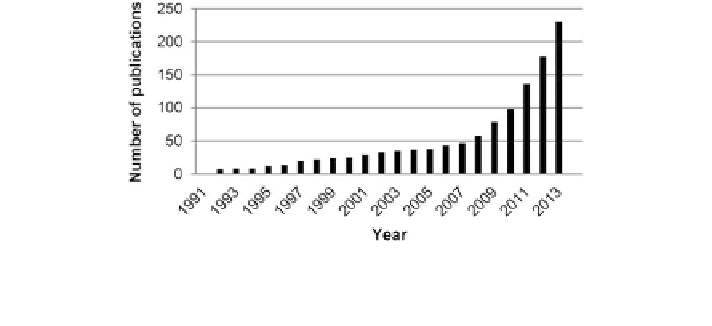Environmental Engineering Reference
In-Depth Information
Fig. 10.15 Total number of publications related to the topic of electrocaloric refrigeration and
heat pumping since 1990. The data were obtained from the online database Web of Science by
searching for the word
“
electrocaloric
”
10.1.4 Introduction to the Pyroelectric Effect
The pyroelectric effect is a property of some dielectric materials that possess a
temperature-dependent polarization (for an explanation of polarization the reader is
referred to Sect.
10.1.1
). This means that as the temperature of the pyroelectric
material changes, the polarization of the material changes as well. Let us now
consider a pyroelectric material with electrodes on both the bottom and top planes,
as shown in Fig.
10.16
a. The number of free charges accumulated on the top and
bottom electrodes, referred to as the surface charge density, is a function of the
polarization of the pyroelectric material and the electric
eld. In the case of a linear
and isotropic material, the surface charge density, also named electric displacement,
can be expressed as [
1
]:
r
¼ e
0
E
þ
P
ð
10
:
12
Þ
where P is the polarization, E is the electric
ε
0
is the electric permittivity of
vacuum. It is clear from Eq. (
10.12
) that a change in the polarization of the
pyroelectric material (due to a temperature change) will have an effect on
the amount of free charges accumulated on the top and bottom electrodes of the
pyroelectric material. If the pyroelectric material is further connected to an electrical
circuit, the change of the temperature of the pyroelectric material will result in a
pyroelectric current [
1
]. A simpli
eld and
ed example of the above description is presented
in Fig.
10.16
(see also [
57
]). The pyroelectric material is initially in a thermal
equilibrium (its temperature does not change with time) and since in this case the
polarization remains constant, no electrical current will
ow (Fig.
10.16
a). How-
ever, when the pyroelectric element is heated, the spontaneous polarization will
decrease and therefore electrons will
fl
ow from the negatively charged plate to the
positively charged plate, creating an electrical current (Fig.
10.16
b). If the material
is then cooled back down to its initial temperature, the polarization of the pyro-
electric material will decrease and the current will
fl
fl
ow in the opposite direction

Search WWH ::

Custom Search